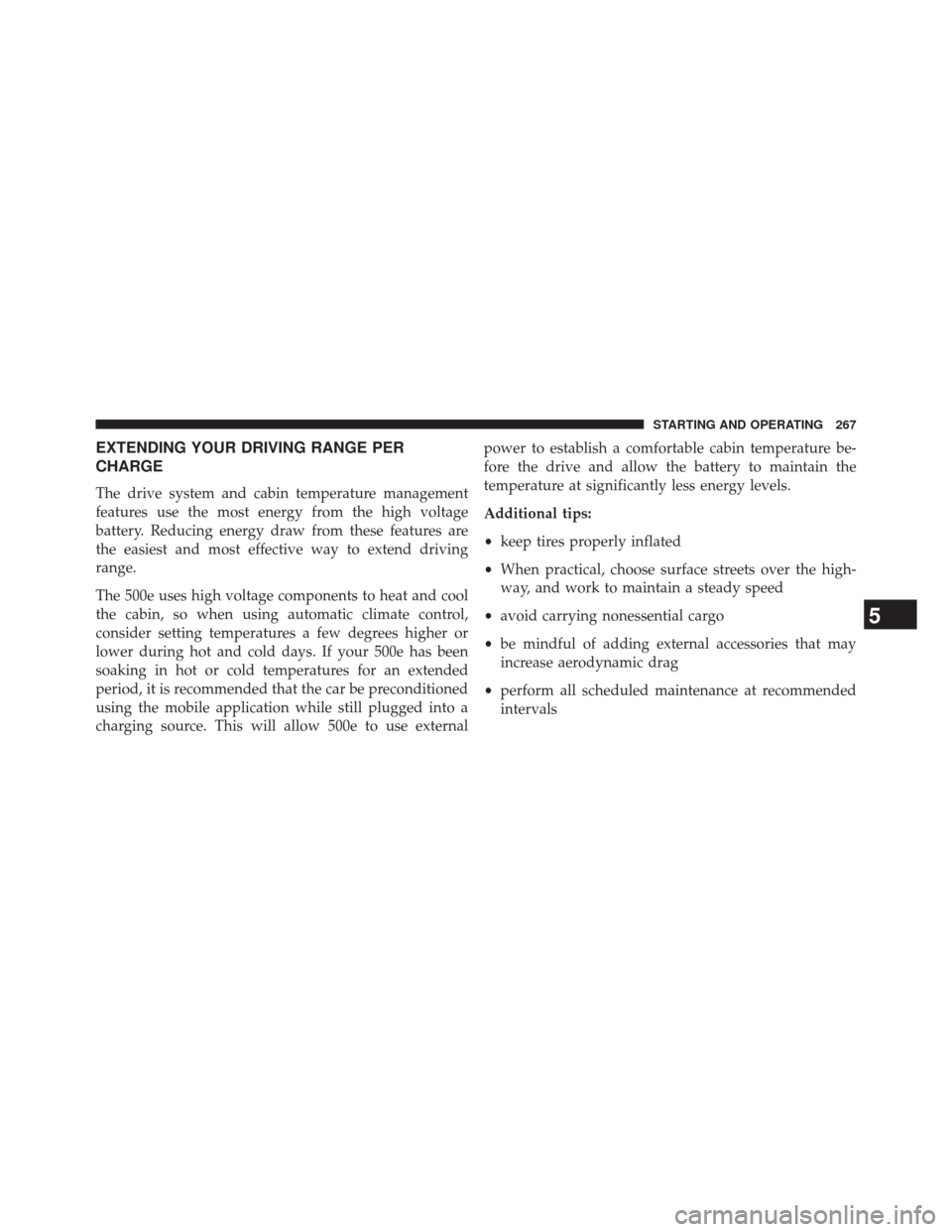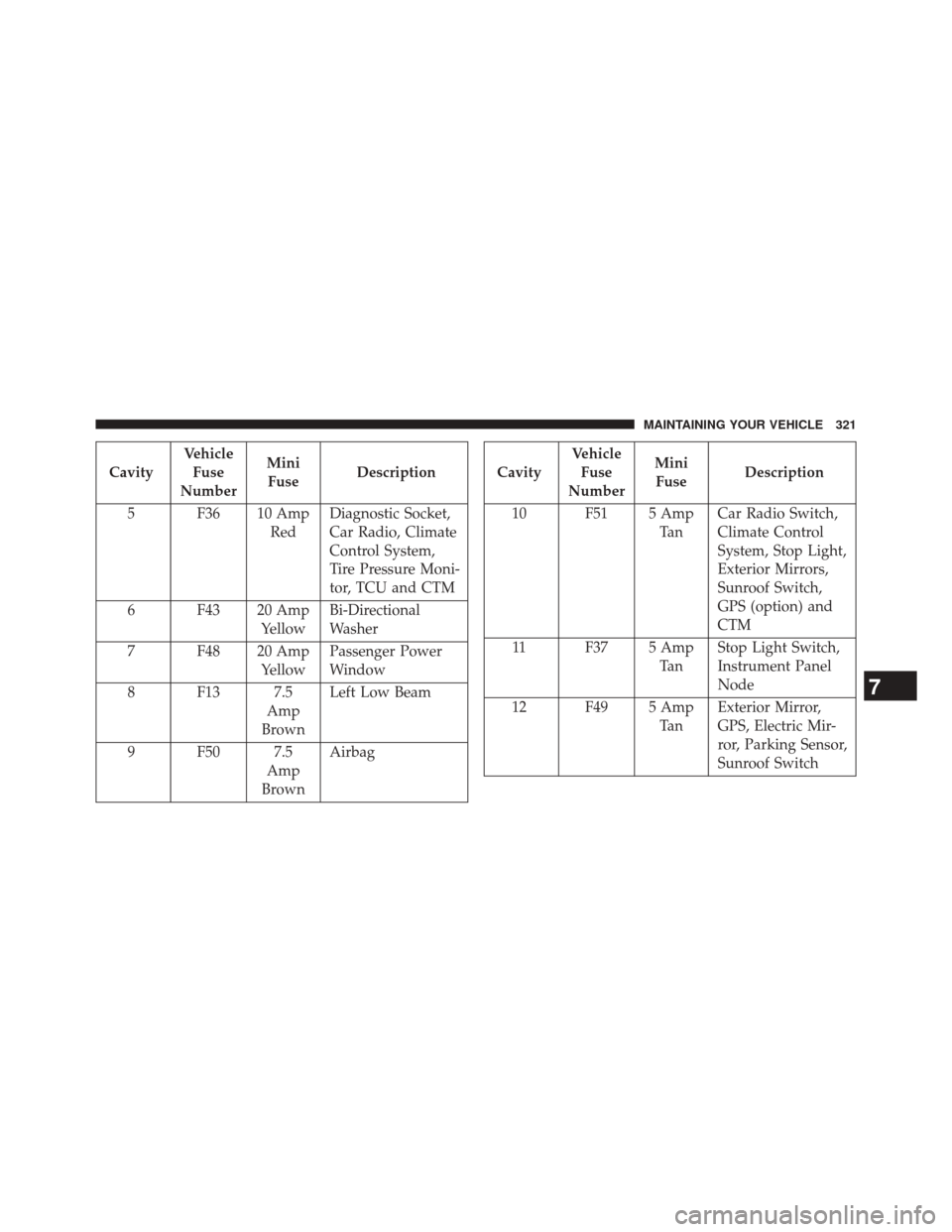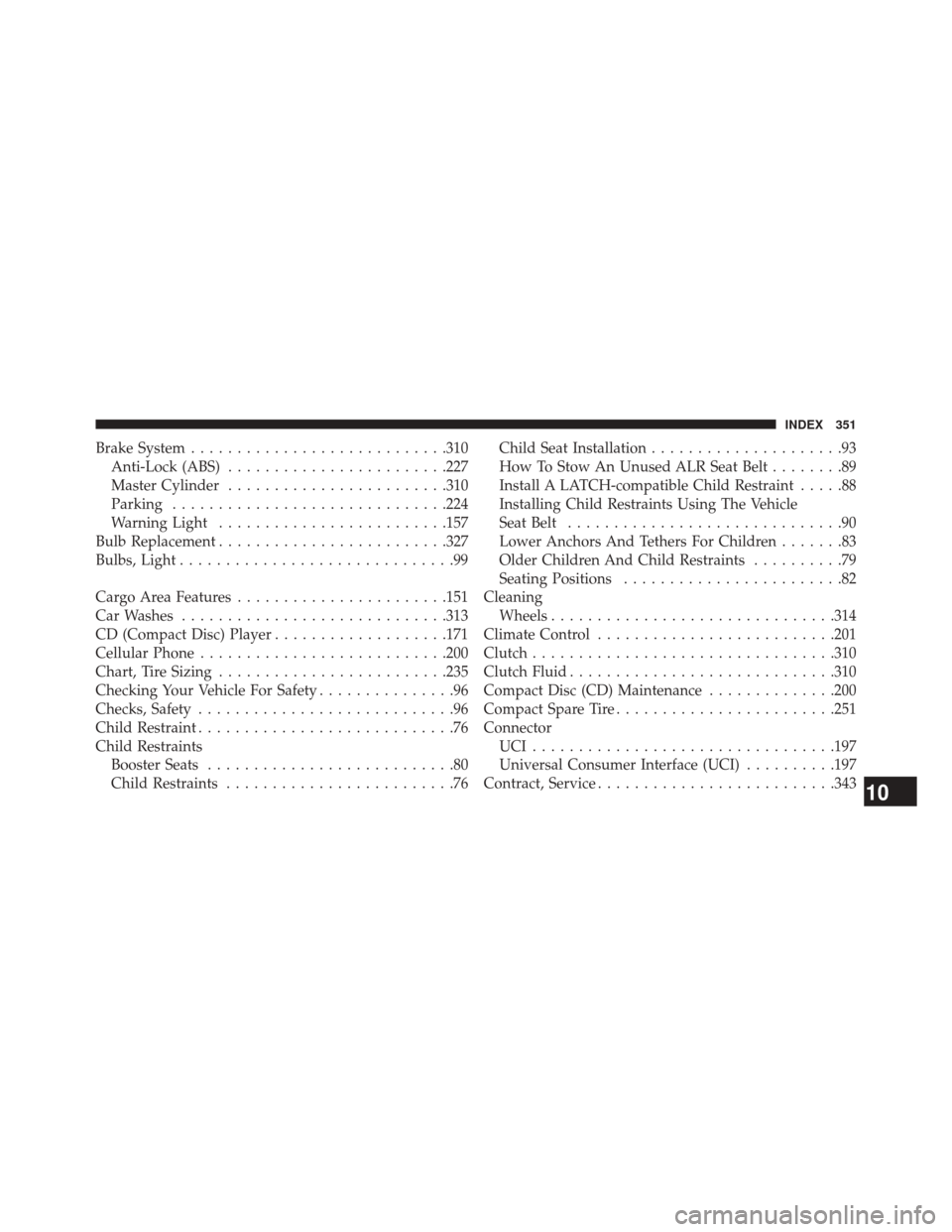climate control FIAT 500E 2014 2.G User Guide
[x] Cancel search | Manufacturer: FIAT, Model Year: 2014, Model line: 500E, Model: FIAT 500E 2014 2.GPages: 363, PDF Size: 2.66 MB
Page 210 of 363

smoke, perfumes, etc.) from sticking to the windows.
Contaminates increase the rate of window fogging.
NOTE:Automatic Temperature Controls (ATC) will au-
tomatically adjust the climate control settings to reduce
or eliminate window fogging on the front windshield.
When this occurs, recirculation will be unavailable.
Summer Operation
NOTE: In some cases during high temperature opera-
tion, the air conditioning system performance may be
reduced. This is to help protect the vehicle from over-
heating during the high load condition.
Your air conditioning system is also equipped with an
automatic recirculation system. When the system senses
a heavy load or high heat conditions, it may use Recir-
culation A/C mode to provide additional comfort while
in automatic mode. Winter Operation
When operating the system during the winter months,
make sure the air intake, located directly in front of the
windshield, is free of ice, slush, snow, or other obstruc-
tions.
Vacation Storage
Anytime you store your vehicle, or keep it out of service
(i.e., vacation) for two weeks or more, run the air
conditioning system at idle for about five minutes in the
fresh air using the high blower setting. This will ensure
adequate system lubrication to minimize the possibility
of compressor damage when the air conditioning system
is started again.
208 UNDERSTANDING YOUR INSTRUMENT PANEL
Page 269 of 363

EXTENDING YOUR DRIVING RANGE PER
CHARGE
The drive system and cabin temperature management
features use the most energy from the high voltage
battery. Reducing energy draw from these features are
the easiest and most effective way to extend driving
range.
The 500e uses high voltage components to heat and cool
the cabin, so when using automatic climate control,
consider setting temperatures a few degrees higher or
lower during hot and cold days. If your 500e has been
soaking in hot or cold temperatures for an extended
period, it is recommended that the car be preconditioned
using the mobile application while still plugged into a
charging source. This will allow 500e to use externalpower to establish a comfortable cabin temperature be-
fore the drive and allow the battery to maintain the
temperature at significantly less energy levels.
Additional tips:
•
keep tires properly inflated
• When practical, choose surface streets over the high-
way, and work to maintain a steady speed
• avoid carrying nonessential cargo
• be mindful of adding external accessories that may
increase aerodynamic drag
• perform all scheduled maintenance at recommended
intervals
5
STARTING AND OPERATING 267
Page 323 of 363

CavityVehicle
Fuse
Number Mini
Fuse Description
5 F36 10 Amp RedDiagnostic Socket,
Car Radio, Climate
Control System,
Tire Pressure Moni-
tor, TCU and CTM
6 F43 20 Amp YellowBi-Directional
Washer
7 F48 20 Amp YellowPassenger Power
Window
8 F13 7.5 Amp
Brown Left Low Beam
9 F50 7.5 Amp
Brown AirbagCavity
Vehicle
Fuse
Number Mini
Fuse Description
10 F51 5 Amp Ta nCar Radio Switch,
Climate Control
System, Stop Light,
Exterior Mirrors,
Sunroof Switch,
GPS (option) and
CTM
11 F37 5 Amp Ta nStop Light Switch,
Instrument Panel
Node
12 F49 5 Amp Ta nExterior Mirror,
GPS, Electric Mir-
ror, Parking Sensor,
Sunroof Switch
7
MAINTAINING YOUR VEHICLE 321
Page 324 of 363

CavityVehicle
Fuse
Number Mini
Fuse Description
13 F31 5 Amp Ta nIgnition, Climate
Control, RDU and
EVCU
14 F47 20 Amp YellowDriver Power
Window
The fuse for the heated mirrors is located behind an
access panel on the front of the Instrument Panel.
NOTE: This fuse is a single fuse attached directly to the
wire harness.
1 — Heated Mirror Fuse 2 — Access Panel
Cavity Mini Fuse Description
F90 5 Amp Tan Heated Mirrors
F90 Fuse Location
322 MAINTAINING YOUR VEHICLE
Page 349 of 363

Treadwear
The Treadwear grade is a comparative rating, based on
the wear rate of the tire when tested under controlled
conditions on a specified government test course. For
example, a tire graded 150 would wear one and one-half
times as well on the government course as a tire graded
100. The relative performance of tires depends upon the
actual conditions of their use, however, and may depart
significantly from the norm due to variations in driving
habits, service practices, and differences in road charac-
teristics and climate.
Traction Grades
The Traction grades, from highest to lowest, are AA, A, B,
and C. These grades represent the tire’s ability to stop on
wet pavement, as measured under controlled conditions on
specified government test surfaces of asphalt and concrete.
A tire marked C may have poor traction performance.
WARNING!
The traction grade assigned to this tire is based on
straight-ahead braking traction tests, and does not
include acceleration, cornering, hydroplaning, or
peak traction characteristics.
Temperature Grades
The temperature grades are A (the highest), B, and C,
representing the tire’s resistance to the generation of heat
and its ability to dissipate heat, when tested under
controlled conditions on a specified indoor laboratory
test wheel. Sustained high temperature can cause the
material of the tire to degenerate and reduce tire life, and
excessive temperature can lead to sudden tire failure. The
grade C corresponds to a level of performance, which all
passenger car tires must meet under the Federal Motor
9
IF YOU NEED CONSUMER ASSISTANCE 347
Page 353 of 363

Brake System........................... .310
Anti-Lock (ABS) ....................... .227
Master Cylinder ....................... .310
Parking ............................. .224
Warning Light ........................ .157
Bulb Replacement ........................ .327
Bulbs, Light ..............................99
Cargo Area Features ...................... .151
Car Washes ............................ .313
CD (Compact Disc) Player ...................171
Cellular Phone .......................... .200
Chart, Tire Sizing ........................ .235
Checking Your Vehicle For Safety ...............96
Checks, Safety ............................96
Child Restraint ............................76
Child Restraints Booster Seats ...........................80
Child Restraints .........................76 Child Seat Installation
.....................93
How To Stow An Unused ALR Seat Belt ........89
Install A LATCH-compatible Child Restraint .....88
Installing Child Restraints Using The Vehicle
Seat Belt ..............................90
Lower Anchors And Tethers For Children .......83
Older Children And Child Restraints ..........79
Seating Positions ........................82
Cleaning Wheels .............................. .314
Climate Control ......................... .201
Clutch ................................ .310
Clutch Fluid ............................ .310
Compact Disc (CD) Maintenance ..............200
Compact Spare Tire ....................... .251
Connector UCI................................ .197
Universal Consumer Interface (UCI) ..........197
Contract, Service ......................... .343
10
INDEX 351